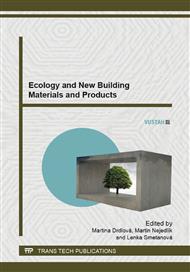p.170
p.174
p.178
p.182
p.186
p.190
p.199
p.203
p.207
Dielectric Spectral Differences for Concrete with Shredded Automobile Tires as an Admixture
Abstract:
This paper gives the information about the dielectric testing of the cement-based composites prepared from a mix of cement mortar and quartz sand, with shredded automobile tires as an admixture, which were intentionally degraded by high-temperature treatment (in the temperature range from 0 °C to 400 °C). The monitoring of structural changes in the thermal stress is very important, for example determining the reliability of the whole structure and influence of polymer admixture on measured dependences. Development of electrical parameters and permittivity at each temperature area reliably shows structural changes and the structural reliability.
Info:
Periodical:
Pages:
186-189
Citation:
Online since:
August 2014
Price:
Сopyright:
© 2014 Trans Tech Publications Ltd. All Rights Reserved
Share:
Citation:


